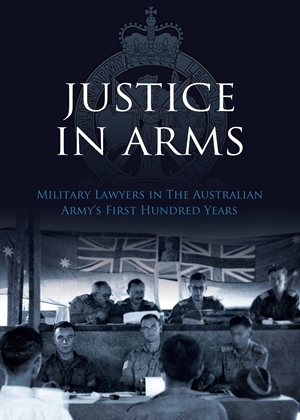As we approach the centenary of the outbreak of World War I, a new book has captured a part of Australia's military history that was in danger of being lost.
Justice in arms: military lawyers in the Australian Army's first one hundred years (Big Sky Publishing 2014) uncovers the role of Army legal officers in Australian and expeditionary operations. Edited by Associate Professor Bruce Oswald with Colonel Jim Waddell, the book brings together nine authors to look at how lawyers in military service have contributed to the development of law and the conduct of military operations in war and peace.

"One thing that struck me in our conversation was how seriously he took his role as a lawyer and how seriously he took his role of doing the right thing in very, very difficult circumstances... He managed to transform the way that people in Vietnam who were captured as Viet Cong were seen by Australian and American personnel," said Associate Professor Oswald.
"That was a singular moment, to meet a man I consider to be an absolute Australian legend. Until that paragraph was written in Justice in Arms, no one would have known about his contribution and that piece of history would have been completely lost."
Jim Waddell agrees with his co-editor, describing the lack of written history of Australian lawyers in the military as a "black void in the consciousness of the Army Legal Corps going back any further than 20 years".
"I wanted to give those in the Legal Corps a sense of their heritage, their identity and to recover an important slice of Australia's military history," he says.
Justice in Arms traces the role of Army legal officers since the Australian Army came into existence in 1901 to give a detailed account of the development of our system of military justice law. It examines how the law has been applied and shaped in military operations ranging from the Boer War and the two world wars to more recent issues such as the involvement of Australian soldiers serving as part of the United Nations Assistance Mission in Rwanda at the time of the Kibeho massacre.
The participating authors in Justice in Arms utilised primary sources, ranging from archival transcripts to interviews with people involved in more recent events, to bring to light research issues that previously had been little written about.
Associate Professor Oswald, who has served in the Australian Regular Army as a legal officer and seen service in Rwanda, the former Yugoslavia, East Timor, Iraq and Afghanistan, says it is important that lessons learnt on military operations be captured.
"This is about human beings functioning in environments that are often quite tough, matching diplomacy, politics, the law, military operations, and trying to find that sweet spot between all of those, so that we can not only defend our country but do so in a lawful and legitimate manner," says Associate Professor Oswald.
Image: Book Cover of Justice in Arms